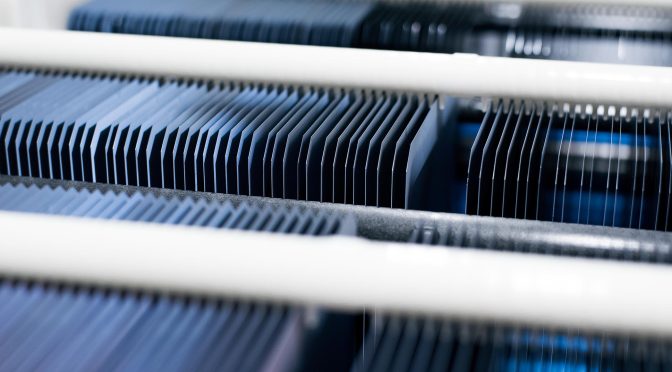Everything started with silicon, but the future is perovskite-silicon tandem technology. Today the “sun factory” in Catania is one of the world’s largest production facilitiy for solar cells and modules, thanks to the continuous evolution of technologies and materials.
Since its inauguration in 2011, our 3Sun Gigafactory has gone on to set the bar worldwide in the production of solar cells and modules. Today it is the largest factory of its kind in Italy, and one of the biggest in Europe. It is also the world’s most advanced photovoltaic production facility: it is capable of operating on a continuous cycle 24 hours a day, 365 days a year with automation and control systems based on the most modern concepts of artificial intelligence, data science and machine learning. Innovation in design and materials at Catania’s “sun factory” are an example of just how much solar technologies have improved over the last decade in terms of performance, reliability and cost.
The key element in solar modules is silicon, a semiconductor material that is abundant in nature: indeed, it is second only to oxygen as the most common chemical element on Earth. The physical principle behind solar energy production is always the same: the sunlight hits the solar cell, “activating” the electrons in the silicon that begin to flow around the circuit, producing an electrical current. Based on the chemical and physical treatments that the silicon has been subjected to, and the manufacturing method of the solar module, it is possible to achieve a higher level of conversion efficiency; in other words, the percentage of sunlight that the system effectively converts into electricity increases.
In 2011 3Sun produced mono-facial modules (which are capable of capturing sunlight only on one side) using thin film technology with an efficiency level of approximately 10%. Around seven million thin film modules were produced up to 2017, when the first technological breakthrough occurred with the production of bi-facial modules. These were equipped with solar cells capable of capturing the sunlight on both sides and a double glass design which made them more resistant to external factors. Thanks to this innovation, the energy produced by these modules increased by 15% compared with mono-facial technology and, at the same time, the lifespan of the modules was extended from 25 to 30 years.
After years of research and development, in 2019 the Catania facility saw the introduction of hetero-junction technology (HJT), which, in combination with the bifacial system, enhanced performance and energy production, increasing panel efficiency from 10% (thin film) to over 20%. In 2020 continuous research enabled our factory to set a global record for the efficiency of commercial cells, achieving a sunlight conversion rate of 24.63%.
Now, in 2022, our efforts in innovation are not only focused on the technological roadmap, but also on sustainability through important actions to reduce CO2 emissions. This is in addition to ensuring the traceability of materials, increasing the efficiency of the production process, reducing waste and recycling modules at the end of their life.
On the technological front, we are looking to the near future and the development of Tandem technology that enables the production of a new generation of solar cells made of various materials. A “bottom” cell uses HJT technology on silicon wafers, while a “top” cell is made of perovskite, considered by many to be the material of the future of solar technologies. Perovskite is in fact an organic-inorganic hybrid material that, when added to a silicon cell, allows a wider range of light wavelengths in the solar spectrum to be converted into electrical current. In particular, perovskite makes it possible to exploit the energy of blue light, unlike silicon cells which are unable to do so.
The use of Tandem technologies, which are expected to be fully up and running at the 3Sun Gigafactory in 2025, promises to further boost the efficiency of photovoltaic modules up to over 30%, while also aiming to ensure a life span of at least 35 years.


